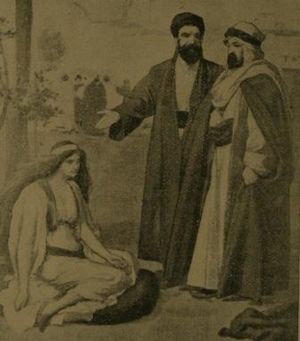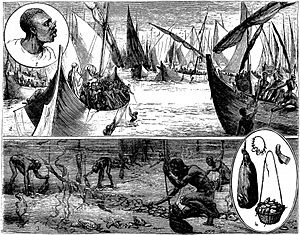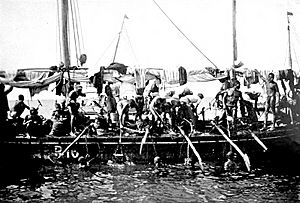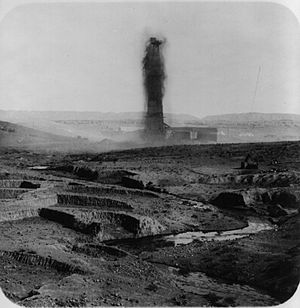Slavery in the Trucial States facts for kids
Slavery was present in the Trucial States from 1892 to 1971. These states later became the United Arab Emirates. The Trucial States included Dubai, Abu Dhabi, Sharjah, Ajman, Umm Al Quwain, Fujairah, and Ras Al Khaimah.
Most enslaved people came from the Indian Ocean slave trade. Others were brought from Hejaz, Oman, and Persia.
It is not fully clear when slavery officially ended in the Trucial States. Some say it was in 1963. This was when the rulers signed an agreement to end slavery. Others believe it was in 1971. That year, the Trucial States joined the UN as the United Arab Emirates. They then accepted the UN's rules against slavery. However, the laws were still unclear. The 1963 agreement was never fully put into action. Also, the 1971 UN law was not strictly required.
Contents
History of Slavery
Slavery and the slave trade caused problems between Britain and the Gulf states. This began after Britain ended slavery in 1833. British laws against slavery did not apply directly to the Trucial States. This was because they were not British colonies. However, the British navy worked to stop the Indian Ocean slave trade. They tried to prevent slave ships from reaching the Gulf from Zanzibar.
Britain and the Trucial rulers signed agreements against the slave trade. These were in 1839, 1847, and 1856. But these agreements were not always followed in the Gulf states. British reports showed that Dubai was a major route for moving enslaved people to Saudi Arabia.
In the 1890s, the British Empire gained control over the area. They formed the Trucial States in 1892. The British managed these states through the India Office and the Foreign Office. However, Britain did not control the internal rules of the Trucial States. They focused on keeping peace with local leaders. They also protected British citizens. And they managed the Trucial States' dealings with other countries. They made sure the Trucial States followed international agreements that Britain had signed. The British found a large slave trade in the area, which had long historical roots.
How People Were Enslaved
During the Omani Empire (1692-1856), Oman was a major center for the Zanzibar slave trade. Enslaved people were brought from the Swahili coast of East Africa through Zanzibar to Oman. From Oman, they were sent to other parts of the Arabian Peninsula and Persia. This included the Trucial States, Qatar, Bahrain, and Kuwait. The Omani slave trade from Africa began to slow down in the late 1800s. But another slave trade route from Africa through Hejaz continued.
Historical records show that most enslaved people in the Persian Gulf's pearl industry came from East Africa or the Horn of Africa.
Another way people were enslaved was through a route from Africa and East Asia. People were secretly brought to Jeddah in the Arabian Peninsula. This often happened during the Muslim pilgrimage, called Hajj, to Mecca and Medina. These enslaved people were then brought from Hejaz to Oman, the Trucial States, Qatar, Bahrain, and Kuwait. Some victims were tricked into traveling, thinking they were going on the Hajj. Others thought they were hired as servants. But they were sold once they arrived. Kidnapping was also used.
In 1927, a court case showed a slave trade group. They brought Indian children, both boys and girls, to Oman and Dubai. This happened through Persia and Gwadar.
In the 1940s, a third slave trade route was noticed. Balochis from Balochistan were shipped across the Persian Gulf. Many had sold themselves or their children to escape poverty.
Most enslaved people were of African origin. But a smaller number came from Asia and Europe. For example, out of 283 enslaved women who sought freedom at the British Agency in Sharjah, 151 were African. The rest included 46 from Baluchistan.
Roles and Living Conditions
Enslaved people were given new names when they arrived. Men's names often meant wealth or power. Women's names were often colorful and suggested beauty. They slowly became part of the local culture and often forgot their past. Even after being freed, many stayed with their former owners' families or as their clients.
Enslaved men worked in many jobs. They were soldiers, pearl divers, farm workers, sailors, dock workers, porters, and domestic servants. Enslaved women mainly worked as domestic servants.
Enslaved Men
In the 1950s, many oil workers in Abu Dhabi were enslaved. In the 1600s and 1700s, European travelers often saw enslaved African soldiers and eunuchs in royal courts.
The slave trade grew a lot in the 1800s. This was because the pearl industry became very important in global trade. This industry relied heavily on enslaved African workers.
The British asked the Trucial states not to use enslaved labor in the oil industries. But the Trucial rulers said it would be hard to find workers without using enslaved people. The British found it difficult to check if oil workers were enslaved or free. The British Foreign Office repeatedly asked the Iraq Petroleum Company not to use enslaved workers. But the company replied that it was the local leaders' job to provide workers.
Enslaved Women
Enslaved women who were not from Africa were sometimes sold for marriage in the Persian Gulf. These were fewer in number. They often came from Armenia, Georgia, or from Baluchistan and India.
In 1943, it was reported that Baloch girls were sent through Oman and the Trucial States to Mecca. They were popular there.
The Temporary Slavery Commission (TSC) of the League of Nations said in 1925 that enslaved women also had the right to freedom. However, the British were careful about enforcing anti-slavery laws when it came to enslaved women in homes. They did not want to cause anger by getting involved in such private matters. They often avoided freeing enslaved women by calling them wives instead of enslaved people.
The number of enslaved women in the Gulf was as high as, or even higher than, the number of enslaved men. But fewer enslaved women applied for freedom at British offices in the Gulf. This was likely because in the Gulf's Islamic society, women were not usually allowed to work for wages or be in public life. This made it very hard for a freedwoman to survive without a male protector.
Efforts Against Slavery
1892-1950: Early Efforts
The British Empire had signed the 1926 Slavery Convention. This meant they had to fight slavery and the slave trade in all areas they controlled. Since the Trucial States were under British influence, Britain was expected to enforce this rule. Officially, Britain said they were doing this. But in reality, slavery and the slave trade in the Trucial States were often allowed by the British.
Like with other Gulf states, the British felt they did not have enough control to stop slavery. The British India Office told British leaders that trying to enforce anti-slavery laws could cause economic and political problems. This was because slavery was "deeply rooted in religious and political history." So, Britain's plan was to tell the League of Nations that the region followed anti-slavery agreements. But at the same time, they prevented any international checks that would show these claims were false.
The British India Office, which also managed the Gulf region, officially reported that British agents had anti-slavery agreements with the local rulers of all the Trucial States, Muscat, and Bahrain, but not Kuwait.
In 1928, the British publicly burned a slave ship in Dubai as a warning. The local leaders, especially the leader of Qatar, said they would follow the agreements. But in reality, this was difficult. The British reported that the local authorities were "fanatical, backward, and intensely suspicious of any European interference."
In both 1932 and 1935, British colonial leaders refused to get involved in slavery in the Trucial States, Qatar, Bahrain, and Kuwait. They feared losing control if they tried to stop slavery. So, they prevented any international checks that might force them to act.
As late as 1935, British leaders told the League of Nations that the Trucial States, Qatar, Bahrain, and Kuwait had banned all slave trading. They said this was done through agreements with the British. But at the same time, the British refused any international visits to the region. Such visits would have shown that a large slave trade was still happening. This was especially true in the pearl fishing industry, where enslaved people were treated very harshly.
In 1936, the British finally admitted to the League of Nations that slavery and slave trade were still happening in the Trucial States, Oman, and Qatar. But they claimed it was limited. They also said that any enslaved person who sought help at the British Agents Office in Sharjah was given freedom. In reality, British reports purposely made the actual size of the slave trade seem smaller. In the 1940s, several ideas were suggested by the British to fight slavery. But none were thought to be easy to enforce.
1950-1970: Growing Pressure
After World War II, there was more international pressure from the United Nations to end the slave trade. After India became independent in 1947, the British Foreign Office took direct control over the Trucial States. For the first time, they felt they had enough control to enforce laws against slavery. This was also because more international people in the Gulf States brought more attention to slavery. This led to stronger international criticism against it.
In 1948, the United Nations said slavery was a crime against humanity in the Universal Declaration of Human Rights. After this, the Anti-Slavery Society pointed out that about one million enslaved people were in the Arabian Peninsula. They said this was against the 1926 Slavery Convention. They asked the UN to form a committee to deal with the issue.
In 1951, the British created the Trucial Oman Levies (later Trucial Oman Scouts) in Sharjah to fight the slave trade.
When slavery in Qatar was ended in 1952, the British asked the Trucial Council (an assembly of Trucial rulers) to do the same. But they refused. They said slavery was allowed in Islam. They also claimed they did not have enough money to pay slave owners for their loss.
The 1956 Supplementary Slavery Convention made a difference between "non-self-governing territories" and "other non-metropolitan territories" like the Persian Gulf states. The British said the Convention did not apply to the Trucial states. But they encouraged the Trucial rulers to end slavery and follow the Convention voluntarily.
In 1957, the British pushed the Gulf rulers to accept the 1956 Supplementary Slavery Convention. Kuwait, Qatar, and Bahrain accepted it. But the rulers of the Trucial coast said such a law could not be enforced. Even when the Trucial rulers did accept the Convention, they did not issue the necessary orders to follow it. The British thought the issue was too sensitive to pressure them further.
In 1958, the British Political Agent in Dubai, John Peter Tripp, urged the Trucial rulers to issue a decree, called an a'lan, to ban slavery. This would fulfill their duties under the 1956 Supplementary Slavery Convention. The Trucial rulers claimed slavery had already ended. But they said they would issue such a decree if the British government wanted them to. In 1963, the British Political Resident Sir William Luce reported that the Trucial rulers had finally signed an agreement to issue a decree to follow the Convention. They claimed they had issued it, but the British found no proof.
After Independence
On December 2, 1971, the Trucial States became independent. They were renamed the United Arab Emirates. They joined the United Nations. As a member, they accepted the Universal Declaration of Human Rights, which bans slavery. However, this did not mean they were forced to follow the Declaration. It was still unclear if slavery was legally forbidden in the Emirates.
Former enslaved people were given citizenship in 1971. Genetic studies show that people in some parts of the Persian Gulf have West African genes. This suggests a history of African populations there.
In the United Arab Emirates, the work once done by enslaved people is now often done by poor migrant workers. These workers are employed under the Kafala system, which some have compared to slavery.
The Kafala System
The United Arab Emirates has a work visa system for foreign workers. This system helps foreign nationals get work permits to move to the UAE for jobs. Most visas are sponsored by companies. A person wanting to work in the UAE gets a work permit, valid for two months, from the Ministry of Human Resources. The company that sponsors them is responsible for medical tests and getting identity cards and other documents. The worker can then sponsor their family members to join them in the UAE.
Under a 2015 rule, an employee whose contract ends can get a new permit. They can also stay in the UAE for six months on a job seeker visa. A new work permit is also given if the employer does not follow legal rules, such as not paying wages for 60 days. A worker can ask to end their contract after at least six months of work. A worker whose job is ended unfairly can get a new work permit without the six-month waiting period.
See also
- Migrant workers in the United Arab Emirates
- Human rights in the United Arab Emirates#Domestic workers
- History of slavery in the Muslim world
- Slavery in Saudi Arabia
- Kafala system





